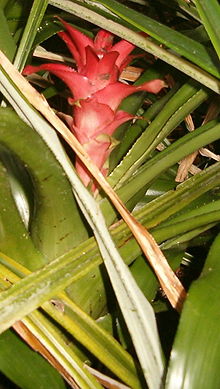Canistropsis
| Canistropsis | ||||||||||||
|---|---|---|---|---|---|---|---|---|---|---|---|---|

Canistropsis billbergioides |
||||||||||||
| Systematics | ||||||||||||
|
||||||||||||
| Scientific name | ||||||||||||
| Canistropsis | ||||||||||||
| Leme |
The plant genus Canistropsis belongs to the subfamily Bromelioideae within the family Bromeliad (Bromeliaceae). The eleven or so species thrive in the rainforest areas only in eastern Brazil .
description
Canistropsis species are perennial herbaceous plants that predominantly grow epiphytically . Sturdy leaves sit on a compressed stem axis and form funnels in which water is collected. The leaves are lightly reinforced.
The inflorescences are often nested in the middle of the cistern, so they hardly protrude beyond the leaf funnel, since the shoot axes also remain compressed in the area of the inflorescences. In some Canistropsis species, the shoot axes are not compressed and the inflorescence clearly protrudes from the funnel. Usually they have very decorative colored bracts .
The pentacyclic (five petal circles), hermaphrodite flowers are radial symmetry and threefold. There are three sepals . The three petals are often blue or white. There are two circles with three stamens each. Three carpels have become an under constant ovary grown.
There are berries formed.
Systematics
The genus name Canistropsis refers to the fact that they look similar to the genus Canistrum ( Greek opsis = appearance, similarity). For a long time, the species were incorporated into one of the two sub-genera of the genus Nidularium , since 1998 (Elton Leme) one of them, Canistropsis , has received genus status (example: Canistropsis billbergioides , syn .: Nidularium billbergioides , Nidularium citrinum ).
There are about eleven species of Canistropsis :
- Canistropsis albiflora (LBSmith) H.Luther & Leme : It only thrives epiphytically in the Brazilian state of Espírito Santo .
-
Canistropsis billbergioides (Schultes & Schultes f.) Leme : There are two forms:
- Canistropsis billbergioides (Schultes & Schultes f.) Leme f. billbergioides : It occurs in the Brazilian states of Bahia and São Paulo .
- Canistropsis billbergioides f. azurea (E.Pereira & Leme) Leme : It occurs only in the Brazilian state of Rio de Janeiro .
- Canistropsis burchellii (Baker) Leme : It thrives at altitudes of 0 to 800 meters only in the Brazilian state of Sao Paulo.
- Canistropsis correia-araujoi (E.Pereira & Leme) Leme : It occurs only in the Brazilian state of Rio de Janeiro.
- Canistropsis elata (E. Perira & Leme) Leme : It thrives terrestrially at altitudes of around 50 meters only in the Brazilian state of Rio de Janeiro.
- Canistropsis exigua (E.Pereira & Leme) Leme : It only thrives at altitudes of 50 to at least 900 meters in the Brazilian state of Sao Paulo.
- Canistropsis marceloi (E.Pereira & Moutinho) Leme : It thrives on rocks at altitudes of 600 to 1000 meters only in the Brazilian state of Rio de Janeiro.
-
Canistropsis microps (E. Morren ex Mez) Leme : There are three forms.
- Canistropsis microps f. bicensis (Ule) Leme : It only occurs in the Brazilian state of Rio de Janeiro.
- Canistropsis microps (E. Morren ex Mez) Leme f. microps : It only occurs in the Brazilian state of Rio de Janeiro and thrives at altitudes of 50 to 1000 meters.
- Canistropsis microps f. pallida (LBSmith) Leme : It occurs only in the Brazilian state of Rio de Janeiro.
- Canistropsis pulcherrima (E. Perira) Leme : It only occurs in the Brazilian state of Rio de Janeiro.
-
Canistropsis seidelii (LBSmith & Reitz) Leme : There are two varieties:
- Canistropsis seidelii (LBSmith & Reitz) Leme var. Seidelii : It thrives epiphytically at altitudes from 0 to 500 meters only in the Brazilian state of São Paulo .
- Canistropsis seidelii var. Welteri A. Seidel ex Roeth : It was first described in 2003 from Sao Paulo and thrives near sea level.
- Canistropsis simulans (E.Pereira & Leme) Leme : It thrives in the shady herbaceous layer of forests, on rocks or epiphytically on the lower area of tree trunks only in the Brazilian state of Rio de Janeiro.
Has not belonged to the genus Canistropsis since 2008 :
- Canistropsis selloana (Baker) Leme → Eduandrea selloana (Baker) Leme, W.Till, GKBrown, JRGrant & Govaerts
use
Some species and varieties are grown in specialist nurseries and so you can find them now and then in garden centers and flower shops. They are very suitable as indoor plants because they are very easy to care for.
swell
- Werner Rauh : Bromeliads - Tillandsias and other bromeliads worthy of culture. Eugen Ulmer, Stuttgart 1990, ISBN 3-8001-6371-3 .
Individual evidence
- ^ Harry E. Luther: An Alphabetical List of Bromeliad Binomials , 2008 in The Marie Selby Botanical Gardens, Sarasota, Florida, USA. Published by The Bromeliad Society International. (PDF file; 314 kB)
- ↑ a b c d e f g h i j k l m n o p q r In “Species Index” click on Canistropsis in Eric J. Gouda, Derek Butcher, Kees Gouda: Encyclopaedia of Bromeliads , Version 3.1 (2012). last accessed on December 12, 2014
Web links
- Canistropsis in the Germplasm Resources Information Network (GRIN), USDA , ARS , National Genetic Resources Program. National Germplasm Resources Laboratory, Beltsville, Maryland.
- Brief information on the genre and pictures. (German)
![{\ displaystyle \ star \; K _ {(3)} \; or \; K_ {3} \; [C _ {(3)} \; A_ {3 + 3}] \; G _ {\ overline {(3) }}}](https://wikimedia.org/api/rest_v1/media/math/render/svg/047e9c8a774df1b93d667b7bce82a505b0bf8fa7)
